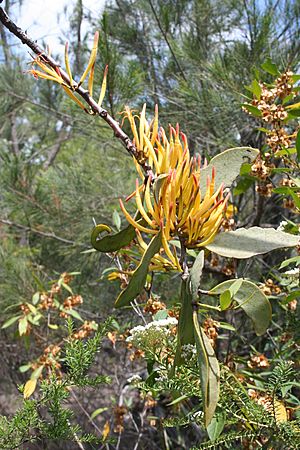Long-flowered mistletoe facts for kids
Quick facts for kids Long-flowered mistletoe |
|
|---|---|
 |
|
| Scientific classification | |
| Genus: |
Dendrophthoe
|
| Species: |
vitellina
|
| Synonyms | |
|
Loranthus vitellinus F. Muell. |
|
The Dendrophthoe vitellina, often called long-flowered mistletoe or apostle mistletoe, is a special plant. It's a hemiparasite, which means it gets some of its food and water from other plants, but it can also make its own food using sunlight. It belongs to the mistletoe family, Loranthaceae. There are about 31 types of Dendrophthoe plants found in tropical Africa, Asia, and Australia. Even though people like Joseph Banks saw this plant way back in 1788, it wasn't officially named until 1860 by Ferdinand von Mueller. Later, Philippe Édouard Léon Van Tieghem gave it its current name in 1895.
Contents
What Does Long-Flowered Mistletoe Look Like?
This mistletoe grows like a bush. It can spread out or hang down from a tree branch or trunk. It has roots that grow on the outside of the tree. Its new shoots are a bit hairy, but as they get older, the branches and leaves become smooth.
Leaves and Flowers
The leaves are shaped like a spear or an oval. They are usually 4 to 16 centimeters (about 1.5 to 6 inches) long and 0.6 to 3 centimeters (about 0.2 to 1.2 inches) wide. The plant produces groups of 5 to 20 small flowers. These flowers are often yellow or orange with red tips. Some plants in northern areas have more red flowers. They are covered in a soft, fine fur.
Fruit and Seeds
After the flowers bloom, the plant grows egg-shaped fruits. These fruits are about 1 to 1.5 centimeters (about 0.4 to 0.6 inches) long and can be red or yellow. Each fruit holds one seed. This seed has a sticky coating, which helps it attach to trees.
How is it Different from Similar Plants?
There's another mistletoe that looks similar, called the smooth-flowered mistletoe (D. glabrescens). But it has smooth flowers and wider leaves. You can find it mostly west of the Great Dividing Range.
Where Does Long-Flowered Mistletoe Live?
You can find the long-flowered mistletoe along the east coast of Australia. Its range stretches from far north Queensland, through New South Wales, and into Victoria. In northern New South Wales, it grows further inland to the Nandewar Range. In Victoria, it's found east of Genoa in East Gippsland.
Its Favorite Homes
This mistletoe usually grows on trees from the Myrtaceae family. These trees are common in open sclerophyll forests, which are forests with tough, dry leaves. It also likes to grow on Eucalyptus grandis trees, especially those found near the edges of rainforests.
How Does Long-Flowered Mistletoe Interact with Other Life?
The long-flowered mistletoe is quite popular in nature! It has been found growing on at least 66 different native plant species. Most of these are from the Eucalyptus, Angophora, and Melaleuca groups. It can even grow on some non-native trees, like the exotic plane tree (Platanus × acerifolia). If it grows on a small red bloodwood tree (Corymbia gummifera), it can be harmful to that tree.
Food for Butterflies and Animals
This mistletoe is a very important food source for many caterpillars. It is the main host plant for the caterpillars of the marbled line blue butterfly (Erysichton palmyra). Many other butterfly caterpillars also eat this plant, including:
- The black jezebel (Delias nigrina)
- The red-banded jezebel (D. mysis)
- The narcissus jewel (Hypochrysops narcissus)
- The silky jewel (H. digglesii)
- The dull oakblue (Arhopala centaurus)
- The black-spotted flash (Hypolycaena phorbas)
- The trident pencil-blue (Candalides margarita)
- The dark purple azure (Ogyris abrota)
- The golden azure (O. ianthis)
- The orange-tipped azure (O. iphis)
- The sapphire azure (O. aenone)
- The southern purple azure (O. genoveva)
- The northern purple azure (O. zosine)
The juicy fruit of the mistletoe is also eaten by the brushtail possum (Trichosurus vulpecula).
How Does Long-Flowered Mistletoe Grow?
When a mistletoe seed lands on a tree, it starts to grow right away. The seedling quickly pushes its way into the tree's water transport system, called the Xylem. This creates a special connection. From that moment on, the young mistletoe plant gets all the water and important minerals it needs from its host tree.

